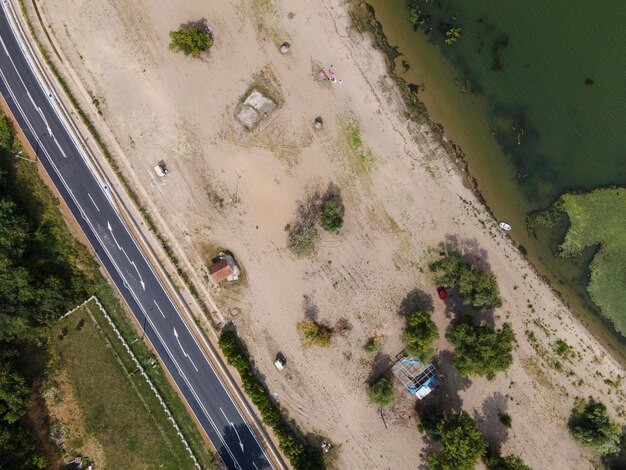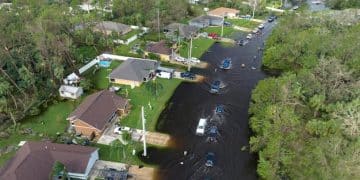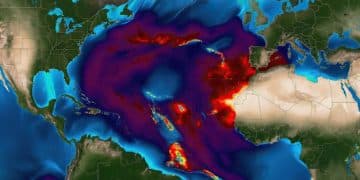Flooding & Waterborne Diseases: Public Health Risks

Extreme weather and public health: understanding the risks of waterborne diseases after flooding is crucial for community safety, as floodwaters can become conduits for harmful pathogens, posing significant threats to human health through contaminated water sources and spread.
In a world grappling with escalating climate patterns, the intersection of extreme weather and public health: understanding the risks of waterborne diseases after flooding has emerged as a critical concern. As flood events become more frequent and intense, their downstream health implications, particularly concerning waterborne pathogens, demand urgent attention and a sophisticated understanding of prevention strategies.
The expanding threat of extreme weather events
The global climate is undergoing profound changes, manifesting as more frequent and severe extreme weather events. Among these, intense rainfall and subsequent flooding stand out as significant environmental disruptions. These events don’t just cause immediate physical damage; they initiate a cascade of secondary impacts, with public health being a primary concern. The sheer volume of water overwhelms infrastructure, displaces communities, and, critically, alters the delicate balance of ecosystems.
The scale of these events often outstrips local preparedness, leading to widespread chaos. This disarray directly impedes sanitation systems, compromises clean water supplies, and creates an environment where disease can proliferate unchecked. Understanding the changing dynamics of extreme weather is the first step in mitigating its health consequences.
Hydrology and pathogen propagation
Floodwaters are not simply displaced rainwater; they are complex mixtures of various contaminants. As water sweeps across landscapes, it picks up everything in its path: sewage, agricultural runoff, industrial waste, and debris. This creates a potent brew where pathogenic microorganisms thrive. The sheer volume of water dilutes some contaminants but simultaneously spreads others over vast areas, including vulnerable communities.
- Sewage overflow: Damaged wastewater treatment plants or overflowing sewer systems release untreated human waste directly into floodwaters, introducing bacteria like E. coli and viruses like norovirus.
- Agricultural runoff: Flooding farmlands can wash animal feces containing pathogens like Cryptosporidium and Giardia into drinking water sources.
- Chemical spills: Industrial sites and storage facilities can release toxic chemicals, adding another layer of complexity to the contamination profile and potentially weakening human immune systems.
The movement of these contaminated waters directly impacts existing clean water infrastructure, compromising wells, boreholes, and municipal water treatment facilities. The challenge lies in the rapid and widespread nature of this contamination, making traditional water safety measures insufficient.
The aftermath of a flood sees a significant increase in the potential for waterborne disease outbreaks. The disruption to routine water purification processes, combined with the widespread presence of pathogens, creates a perfect storm. Furthermore, displaced populations often resort to unsafe water sources, compounding the risk. This highlights a critical public health challenge that requires both immediate and long-term strategic responses to protect communities.
Decoding waterborne diseases: a public health lexicon
Waterborne diseases represent a significant threat to global public health, particularly in the wake of environmental disasters like flooding. These illnesses are caused by pathogenic microorganisms transmitted through contaminated water. Understanding the specific nature of these diseases, their causative agents, and their transmission pathways is fundamental to developing effective prevention and response strategies.
The spectrum of waterborne diseases is broad, ranging from acute gastrointestinal illnesses to more severe, systemic infections. Their common denominator is the ingestion of water compromised by fecal matter, which harbors a multitude of disease-causing organisms. This underscores the critical importance of maintaining access to safe and clean drinking water, especially when natural disasters disrupt conventional supply chains.
Common culprits in floodwaters
Upon floodwaters receding, the risk of various waterborne diseases intensifies. Several pathogens are particularly concerning due to their prevalence, resilience in water, and potential for widespread outbreaks. Identifying these common culprits is essential for targeted intervention and public health advisories.
- Cholera (Vibrio cholerae): This bacterium causes severe diarrheal illness that can lead to rapid dehydration and death if untreated. It spreads explosively in environments with poor sanitation and contaminated water.
- Typhoid Fever (Salmonella Typhi): Characterized by high fever, fatigue, and gastrointestinal symptoms, typhoid is transmitted through the ingestion of food or water contaminated with the feces of an infected person.
- Leptospirosis (Leptospira bacteria): Unlike other waterborne diseases, leptospirosis can be contracted through contact with contaminated water via skin abrasions, eyes, or mucous membranes, not just ingestion. Symptoms range from mild flu-like illness to severe organ damage.
- Hepatitis A (Hepatitis A virus): This viral infection affects the liver and is typically spread through fecal-oral contamination, often via contaminated water or food.
- Gastrointestinal illnesses (E. coli, Giardia, Cryptosporidium): A broader category encompassing various pathogens that cause diarrhea, nausea, and cramping. These are frequently found in floodwaters due to sewage and animal waste contamination.
These pathogens vary in their incubation periods, severity, and required treatment, but all pose a considerable challenge to public health systems in post-flood scenarios. Early detection, rapid response, and community education are vital in managing and containing potential outbreaks.

The pathways of contamination: how floodwaters infect
The journey of pathogens from contaminated floodwaters to human infection is multifaceted, involving several direct and indirect exposure routes. Understanding these pathways is crucial for developing effective preventative measures and informing public health warnings. It’s not just about drinking contaminated water; contact with it in various forms poses significant risks.
When floods displace populations and disrupt infrastructure, the normal barriers preventing disease transmission are often breached. This creates new and amplified vectors for infection, turning common activities into potential health hazards. Public awareness of these varied exposure routes is as important as the professional response to them.
Direct and indirect exposure routes
Exposure to waterborne pathogens after floods can occur through immediate contact or through intermediary steps. Both categories present unique challenges for prevention and control.
- Ingestion of contaminated drinking water: This is the most direct and common pathway. Floodwaters can infiltrate and contaminate private wells, municipal water supplies, or burst pipes, leading to widespread exposure when individuals consume untreated or improperly treated water.
- Contact during recreational activities: Children playing in floodwaters, or individuals attempting to navigate submerged areas, can absorb pathogens through cuts, open wounds, or mucous membranes (eyes, nose, mouth). Even seemingly innocuous activities like swimming or wading can be dangerous.
- Food contamination: Floodwaters can contaminate agricultural produce in fields, or food stored in flooded homes and businesses. Consuming unwashed or improperly cooked food that has been exposed to floodwaters can lead to illness.
- Inhalation of aerosols: While less common for typical waterborne diseases, certain pathogens can become airborne as aerosols during strong winds over contaminated waters or through spray from contaminated sources, potentially leading to respiratory illnesses.
- Secondary transmission: Once an individual is infected, they can become a source of further transmission, especially in crowded shelters or temporary housing, if proper hygiene practices are not meticulously followed. This highlights the importance of broader public health interventions beyond water treatment.
The interconnectedness of these pathways means that a comprehensive public health response requires multi-pronged interventions, addressing water safety, hygiene, food handling, and community education simultaneously.
Public health interventions: mitigating the risks
In the face of extreme weather events and increased risks of waterborne diseases, robust public health interventions are paramount. These strategies must encompass immediate emergency responses and long-term preparedness to effectively protect communities. A reactive approach alone is insufficient; proactive planning and integrated systems are key to resilience.
Effective interventions rely on a coordinated effort between various governmental agencies, non-profit organizations, and local communities. They address not just the symptoms of contamination but also the structural vulnerabilities that amplify the health risks associated with flooding. From communication to infrastructure, every aspect plays a role.
Immediate response and long-term planning
Mitigating the health risks associated with flood-related waterborne diseases requires a two-tiered approach: rapid, decisive action during and immediately after an event, and strategic, sustained efforts during periods of normalcy. Both are indispensable for comprehensive public health protection.
Immediate Response Actions:
- Emergency water supply: Rapid deployment of bottled water or establishment of safe, temporary water purification stations to provide immediate access to clean drinking water for affected populations.
- Boil water advisories: Issuing public health warnings to boil all tap water before consumption or use, even if it appears clear. This is a critical first step to prevent widespread illness.
- Water testing and surveillance: Promptly testing water sources (wells, municipal systems) for bacterial and viral contamination to identify unsafe areas and guide remediation efforts.
- Disease surveillance and reporting: Establishing enhanced surveillance systems to detect increases in waterborne disease cases early, allowing for rapid investigation and containment.
- Hygiene promotion: Disseminating clear messages on handwashing, safe food preparation, and avoiding contact with floodwaters to reduce secondary transmission.
- Sanitation facilities: Setting up temporary, safe sanitation facilities for displaced populations to prevent further contamination of the environment.
Long-Term Planning and Preparedness:
- Infrastructure upgrades: Investing in resilient water and wastewater treatment plants, elevating critical facilities, and ensuring backup power supplies to withstand future extreme weather events.
- Early warning systems: Developing and improving flood forecasting and public health alert systems to provide communities with sufficient time to prepare and take preventative measures.
- Community education and outreach: Continuous public awareness campaigns on water safety, emergency preparedness, and signs/symptoms of waterborne diseases.
- Stockpiling supplies: Maintaining reserves of water purification tablets, hygiene kits, and essential medical supplies for rapid distribution during emergencies.
- Inter-agency coordination: Establishing clear protocols and communication channels between health departments, emergency management agencies, and utilities for seamless response.
By integrating these immediate and long-term strategies, communities can build greater resilience against the health challenges posed by the increasing frequency and intensity of extreme weather events.
Case studies and lessons learned: floods and outbreaks
Analyzing past events provides invaluable insights into the complex relationship between flooding and waterborne disease outbreaks. Each incident, though unique in its specifics, offers crucial lessons for preparedness, response, and public health policy. These case studies underscore the recurring vulnerabilities and the effectiveness of certain interventions.
From densely populated urban centers to remote rural communities, the impact of flood-induced water contamination transcends geographical boundaries. Understanding what went wrong and, crucially, what went right in previous emergencies helps to fortify future public health defenses against the relentless march of extreme weather.
Notable flood-related disease outbreaks
Throughout recent history, numerous flood events have been followed by significant outbreaks of waterborne diseases, illustrating the direct link between environmental disaster and public health crises. Examining these instances provides tangible evidence of the challenges faced and the lessons learned.
One prominent example is the aftermath of Hurricane Katrina in 2005, which devastated New Orleans and the Gulf Coast region. While the immediate concerns were search and rescue, the extensive flooding led to widespread contamination. The sheer volume of standing water, laden with sewage and industrial pollutants, created ideal conditions for bacterial growth. Although widespread cholera or typhoid outbreaks were largely averted, there were significant increases in gastrointestinal illnesses, skin infections related to contaminated water exposure, and cases of less common pathogens like Vibrio vulnificus.
Another significant event was the 2010 flood in Pakistan, which submerged vast swathes of agricultural land and disrupted water infrastructure for millions. This disaster led to a surge in acute watery diarrhea (AWD), cholera, and typhoid cases, particularly in temporary displacement camps. The challenges included inadequate sanitation, limited access to safe drinking water, and overburdened healthcare facilities, highlighting the critical role of humanitarian aid and rapid public health intervention in such large-scale emergencies.
More recently, several severe flooding events across the Midwestern US have demonstrated how even in developed countries, infrastructure can be overwhelmed. These events have often necessitated boil-water advisories for vast areas, with specific localized outbreaks of E. coli or Cryptosporidium occurring in communities where water treatment plants were compromised or private wells contaminated.
These case studies universally point to common themes: the critical importance of swift and effective communication of risks to the public, the need for robust emergency water supply plans, and the enduring challenge of maintaining sanitation in displaced populations. They also highlight the need for adaptable water treatment technologies suitable for emergency deployment.
The lessons learned from these outbreaks emphasize that reducing the public health burden of flooding requires not only resilient infrastructure but also strong community engagement and a responsive public health workforce capable of immediate situational assessment and intervention. Proactive investment in these areas is the most effective defense against future crises.
Community resilience and individual preparedness
While governmental and institutional responses are crucial, the concept of community resilience and individual preparedness forms the bedrock of effective disaster mitigation. Empowering individuals and communities with knowledge and resources can significantly reduce vulnerabilities and expedite recovery after extreme weather events, especially concerning waterborne disease risks.
Resilience is not merely about bouncing back; it’s about adapting and thriving in the face of adversity. This involves fostering a culture of readiness, where every household understands its role in safeguarding public health during emergencies. Such a proactive stance can dramatically lessen the health burden when floods strike.
Empowering self-protection
Individual and community preparedness for waterborne disease risks after flooding involves practical steps that can be taken before, during, and after a flood event. These measures empower individuals to protect themselves and their families when external support might be delayed or stretched thin.
- Emergency kit preparation: Assembling a disaster kit that includes at least a three-day supply of non-perishable food and, critically, at least one gallon of water per person per day. Also include water purification tablets or a portable water filter.
- Understanding boil water advisories: Knowing what a boil water advisory means and how to effectively boil water to make it safe for consumption (a rolling boil for at least one minute).
- Safe water storage: Learning how to safely store clean water in disinfected containers, away from floodwaters and contaminants.
- Personal hygiene practices: Emphasizing rigorous handwashing with soap and clean water (or hand sanitizer if water is scarce) after contact with floodwaters or handling potentially contaminated items.
- Avoiding floodwater contact: Educating on the dangers of playing, swimming, or wading in floodwaters due to unseen hazards and microbial contamination.
- Food safety in floods: Understanding that any food product that has come into contact with floodwater must be considered contaminated and discarded, especially perishables. Proper cleaning and disinfection of kitchens and cooking utensils after flooding.
- Community action plans: Participating in local emergency preparedness efforts, knowing evacuation routes, and identifying community shelters or safe zones. Establishing a communication plan with family members.
Beyond these immediate actions, fostering a sense of collective responsibility within communities can lead to stronger social networks that support vulnerable individuals. Neighborhood watch groups, volunteer organizations, and local health initiatives all play a vital role in amplifying preparedness messages and providing mutual aid.
Ultimately, investing in community and individual preparedness is an investment in public health security. It reduces reliance on external aid during crises and builds a more robust, adaptable society capable of confronting the growing challenges posed by extreme weather events.
Future outlook: climate change, technology, and policy
Looking ahead, the intertwined challenges of extreme weather and public health demand innovative solutions that integrate climate science, technological advancements, and responsive policy. As climate change continues to intensify flood risks, our strategies for preventing waterborne diseases must evolve beyond traditional approaches, embracing foresight and resilience.
The future outlook necessitates a holistic perspective, recognizing that preventing disease outbreaks in a changing climate is not solely a medical or engineering problem; it’s a societal one requiring interdisciplinary collaboration and adaptive governance. Proactive efforts now will determine the health security of generations to come.
Innovations and adaptive strategies
The path forward in addressing waterborne disease risks after flooding involves harnessing technological innovations and developing adaptive policies that can respond to an unpredictable future. These strategies aim to enhance early warning, improve water quality monitoring, and bolster community defenses.
- Advanced forecasting and early warning systems: Leveraging AI and machine learning to integrate climate models with hydrological data for more accurate and localized flood predictions. This allows for earlier warnings and better preparation for communities at risk.
- Real-time water quality monitoring: Deploying smart sensors and rapid diagnostic tools that can detect pathogens and contaminants in water sources instantly, providing actionable data for public health officials.
- Decentralized water treatment solutions: Investing in portable, modular, and sustainable water purification technologies (e.g., solar-powered purifiers, advanced filtration systems) that can be quickly deployed in affected areas, reducing reliance on centralized, vulnerable infrastructure.
- Climate-resilient infrastructure: Designing and upgrading water and wastewater systems with climate change impacts in mind, ensuring they can withstand higher flood levels, storm surges, and changes in precipitation patterns. Examples include elevated treatment plants and permeable urban surfaces.
- Nature-based solutions: Implementing ecological approaches such as restoring wetlands, creating green infrastructure, and managing floodplains to naturally absorb excess water and filter pollutants, thereby reducing the burden on grey infrastructure and naturally mitigating flood risks.
- Policy frameworks for adaptation: Developing national and international policies that mandate climate risk assessments for infrastructure projects, incentivize resilient building codes, and establish mechanisms for rapid funding and resource allocation during climate-induced disasters.
- Integrated public health and climate services: Fostering stronger collaboration between public health agencies, meteorological departments, environmental protection bodies, and emergency management services to create comprehensive, integrated disaster response plans.
The future of public health in an era of extreme weather will depend heavily on our ability to embrace these innovations, adapt our policies, and foster a culture of perpetual learning and preparedness. It’s a continuous journey of scientific advancement, strategic planning, and community empowerment.
Ultimately, a resilient future is one where societies are not merely reactive to climate disasters but are proactively designed to minimize their health impacts. This requires sustained investment, political will, and a collective commitment to safeguarding human health against the backdrop of a changing planet.
| Key Point | Brief Description |
|---|---|
| 🌊 Flood Risks | Extreme weather increasingly causes floods, disrupting sanitation and clean water, creating conditions for disease spread. |
| 🦠 Waterborne Threats | Floodwaters carry pathogens from sewage, agriculture, and waste, leading to illnesses like cholera, typhoid, and GI issues. |
| 🛡️ Public Health Action | Interventions include emergency water, boil advisories, active surveillance, and long-term infrastructure upgrades. |
| 💡 Preparedness | Individual emergency kits, safe water storage, and community education are vital for reducing risk and aiding recovery. |
Frequently asked questions
Waterborne diseases are illnesses caused by pathogenic microorganisms transmitted through contaminated water. After flooding, these diseases become a major concern because floodwaters often become contaminated with sewage, agricultural runoff, and other pollutants, creating ideal conditions for bacteria, viruses, and parasites to proliferate and spread.
Flooding can overwhelm and damage water and wastewater treatment systems, leading to overflows of untreated sewage into water sources. It can also inundate wells, allowing pathogens from the ground to seep into drinking water. The widespread distribution of floodwaters means contaminants can be carried over vast areas, affecting previously safe supplies.
Common waterborne diseases after a flood include cholera, typhoid fever, leptospirosis, hepatitis A, and various gastrointestinal illnesses caused by bacteria like E. coli or parasites like Giardia and Cryptosporidium. Symptoms typically range from diarrhea, nausea, and vomiting to fever and more severe systemic infections, depending on the pathogen.
Immediately after a flood, assume all tap water is unsafe. Boil any water intended for drinking, cooking, or brushing teeth for at least one minute at a rolling boil. Use bottled water if available. Avoid contact with floodwaters, wash hands frequently with soap and clean water, and discard any food that has come into contact with floodwaters.
Communities can prepare by upgrading water and wastewater infrastructure to be more resilient to floods, developing robust early warning systems, and stockpiling emergency water purification supplies. Public education campaigns on water safety, personal hygiene, and emergency preparedness are also vital for fostering community-wide resilience.
Conclusion
The convergence of extreme weather events and public health presents an urgent and growing challenge, particularly concerning waterborne diseases after flooding. As climate patterns intensify, understanding the intricate pathways of contamination and implementing robust, multi-faceted interventions becomes not just important, but essential for safeguarding community health. From immediate emergency responses to long-term resilient infrastructure and empowered community preparedness, a holistic approach is paramount. The lessons learned from past outbreaks, coupled with forward-thinking technological and policy innovations, illuminate the path towards a more secure and adaptable future, ensuring that clean water and public health remain protected in the face of environmental shifts.





